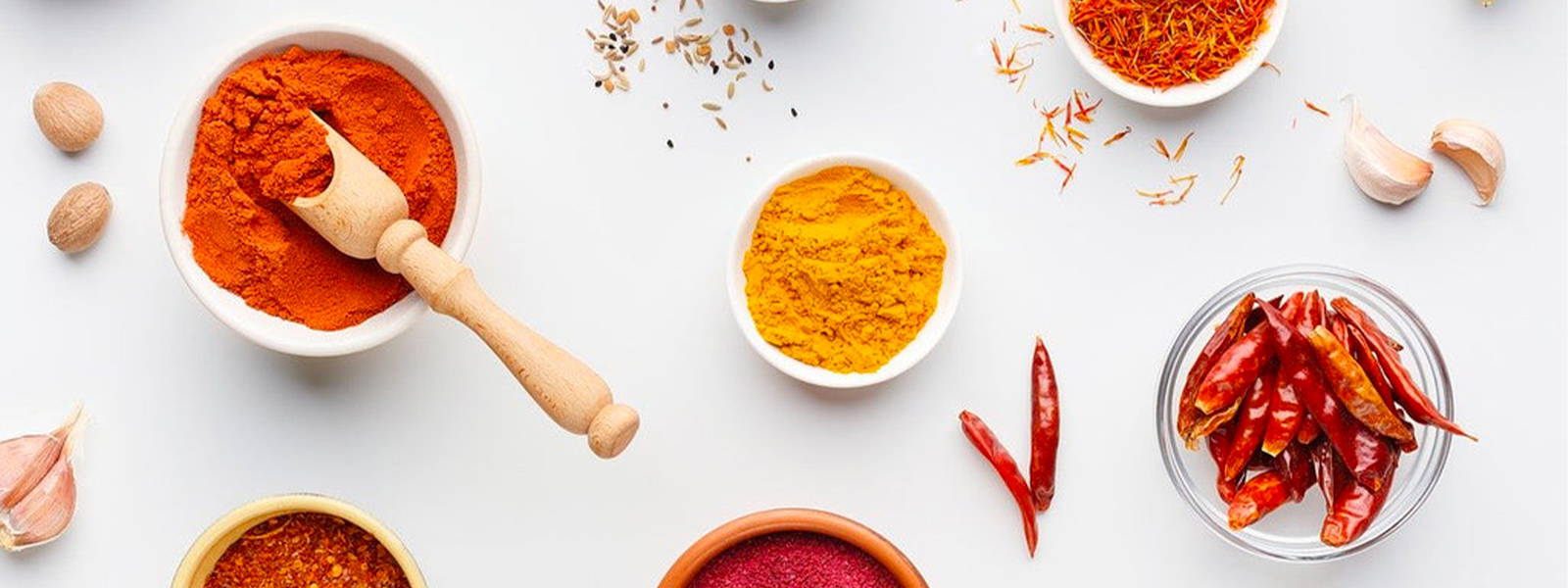
Les bienfaits des épices pour la peau
Qui n’a pas entendu parler de la route (romaine) des épices ? Ce surnom à cette route maritime témoigne de l’importance du commerce des épices depuis l’Antiquité. Les épices étaient prisées avant tout pour leur fonction de remède médicinal bien plus que pour leurs vertus gastronomiques comme c’est le cas aujourd’hui. Au fil du temps, leur efficacité dans le traitement et le soulagement des maux a été largement prouvée, mais pas que ! Outre leur pouvoir purifiant, anti-inflammatoire et anti-infectieux, elles détiennent aussi une capacité anti-oxydante extrêmement efficace pour maintenir la vitalité et la jeunesse des petites cellules de notre peau. Sur le plan diététique, elles permettent aussi de rehausser le goût des plats et limiter ainsi le recours au sel et au sucre. Alors profitez du temps libre de ces fêtes pour en faire usage en les variant. On vous a concocté une petite sélection pour parfumer vos plats salés et sucrés mais aussi vos tisanes et boissons.

NABILA
Décembre 2020
1. le curcuma
C’est une plante rhizomateuse originaire d’Asie du Sud-Est. Sa tige souterraine produit, après séchage et broyage, une poudre de couleur jaune d’or aux usages multiples.
C’est l'un des antioxydants les plus puissants grâce à la curcumine, un de ses principes actifs, qui possède également d’extraordinaires pouvoirs digestifs (stimulation de l’activité du foie) qui fait du curcuma un ingrédient clé des cures de détox.
Outre son action rajeunissante, il est aussi très apprécié pour soulager les peaux enflammées par des rougeurs, des démangeaisons, de l’acné ou encore de l’eczéma et pour favoriser la cicatrisation de plaies.
Il est également efficace pour purifier la peau, réguler l'excès de sébum, éclaircir et raviver les teints ternes.
Alors avant de profiter de ces bienfaits en l’incorporant à toutes vos préparations de plats, sachez que si vous voulez faire le plein de curcumine, il serait bon de le consommer en rhizome ou en jus. Si vous ne l’avez qu’en poudre, associez-le au poivre noir fraîchement moulu pour favoriser l’assimilation de la curcumine par le corps.
2. LA CARDAMOME
Encore une plante rhizomateuse originaire d’Asie du Sud-Est qui fait partie de la même famille - les zingibéracées – que le gingembre et le curcuma. L’épice utilisée en cuisine est la poudre du fruit séché. Elle a une saveur citronnée et délicatement poivrée. La cardamome booste l'appétit et favorise la digestion en stimulant la sécrétion de salive.
Grâce à ses deux principaux principes actifs - l'acétate d'alpha-terpényle et l'oxyde terpénique - la cardamome jouit d’une action tonique et raffermissante bien bénéfique pour notre peau. Elle possède également une teneur intéressante en zinc et en vitamine B6 qui sont des acteurs clés pour préserver la jeunesse et la pureté de votre peau. C’est donc l’alliée des peaux matures et des peaux grasses
Elle a également un effet très bénéfique sur le système digestif. En croquant quelques graines en fin de repas, vous limiterez les remontées acides et vous neutraliserez les odeurs fortes comme celle de l'ail.
Son goût est très fort, il vaut mieux donc l’utiliser sous forme de poudre pour pouvoir doser plus facilement lorsque vous voulez parfumer vos plats, vos desserts ou vos boissons chaudes.
3. LE GINGEMBRE
Très riche en composés antioxydants (carotènes, flavonoïdes, etc..), la racine du gingembre se distingue par une activité anti-oxydante qui résiste voire augmente à la chaleur, rendant son usage encore plus varié !
Le gingembre cru est une source importante de vitamine C, E, A, d’acides aminés, de minéraux et de zinc et de cuivre. Ces oligoéléments sont nécessaires à la formation du collagène et à la défense contre les radicaux libres. Il nous permet ainsi d’avoir une peau ferme, repulpée et énergique.
Il se marie très bien aussi bien avec les plats salés ou sucrés, chauds ou froids, cuits ou crus. Pour en tirer le meilleur profit, consommez le frais. Le gingembre jamaïcain est le plus apprécié pour son arôme délicat.
4. LE SAFRAN
Cette épice n’est pas une racine, ce sont les stigmates rouges déshydratés de la fleur de Crocus sativus L. ; une plante vivace à floraison automnale. Sa cueillette se déroule à l’aube avant qu’elle ne s’ouvre donc sur un laps de temps très court. Il faut compter environ 1 kilo de fleurs pour obtenir 12 grammes d’épices...
Cet « or rouge » tire sa couleur jaune-or de la crocine, un antioxydant, très puissant. Il renferme près d’une centaine de composés qui dérivent pour la plupart de caroténoïdes (zéaxanthine, lycopène, β-carotènes, etc.). C’est donc l’épice « rajeunissante » par excellence pour votre peau ! C’est aussi un excellent antiseptique qui aide à traiter les boutons, l'acné et d'autres maladies de la peau.
Le safran séché est très sensible à la lumière et à l’oxydation de manière générale, il faut donc le stocker dans un récipient hermétique à l’air et à la lumière.
Plusieurs pays le cultivent mais l’Iran reste le plus gros producteur mondial avec plusieurs variétés de cultivars. Le safran de L'Aquila en Italie est réputé pour sa concentration élevée en crocine offrant un arôme particulièrement intense.
5. LA VANILLE
Synonyme d’enfance et de douceur, la vanille renferme en son cœur des petits grains noirs au parfum sucré, qui contribuent à lutter contre le vieillissement et à retrouver une peau belle et lumineuse.
Son obtention est un long processus qui peut durer jusqu’à 12 mois. Les gousses de vanille récoltées sont vertes et ne dégagent encore aucun arôme. Rassemblées dans des paniers d’osiers, elles sont d’abord lavées à l’eau chaude pour permettre le développement de l’arôme puis séchées pour stabiliser les gousses et éviter les moisissures et enfin affinées.
La vanille permet tout d’abord, grâce à son action anti-inflammatoire et régénérante, de purifier et d’apaiser la peau en réduisant boutons et acné et de favoriser la cicatrisation. Elle est dotée d’une richesse en vitamines du groupe B essentielles à la régénération cellulaire. Son pouvoir hydratant et antioxydant complète la palette et offre ainsi une action globale sur tous les signes du vieillissement cutané.
Une fois utilisée, surtout ne la jetez pas mais placez la dans votre bocal de sucre, elle continuera à le parfumer. La vanille Bourbon provenant de Madagascar ou de l’ile de la Réunion reste la vanille de référence.
À vous de jouer, régalez vos papilles et vos petites cellules. Si ces épices permettent toutes de lutter contre le vieillissement, il vous restera tout de même à veiller à la qualité et à la conservation dans un bocal hermétique pour préserver leurs bénéfices.
Bonnes fêtes épicées !
